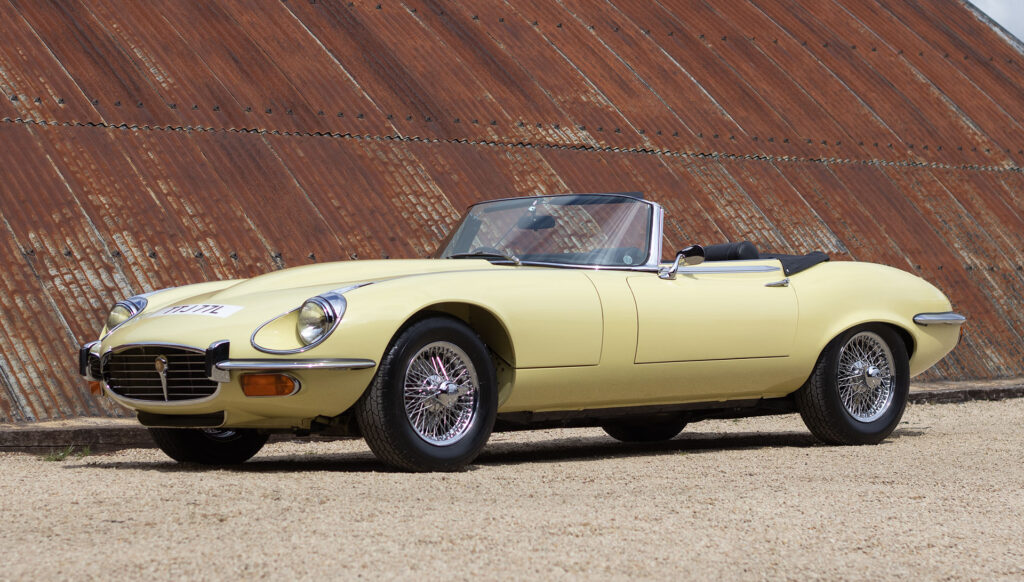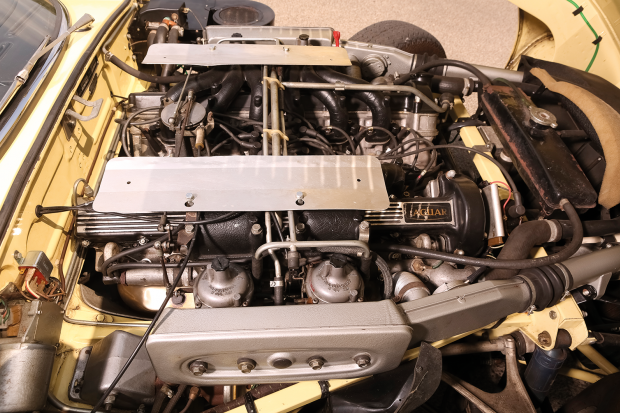
Introduction: Jaguar E-Type Series III (1971-1975)
The Jaguar E-Type Series III, produced between 1971 and 1975, marked a significant change in the iconic E-Type lineage. Introduced at the Geneva Motor Show in March 1971, the Series III was both a departure from and a continuation of its predecessors. This comprehensive history explores its design, racing pedigree, innovative features, and overall legacy.
Design: The New Face of E-Type
- Exterior Evolution: The Series III displayed a noticeable change from its forebears. Designers, including Malcolm Sayer, who had been integral to previous E-Type designs, enlarged the grille and flared the wheel arches, enhancing the car’s aggressive stance. The longer and wider body accommodated the new V12 engine, adding to the car’s aesthetic appeal.
- Interior Upgrades: The interior received substantial upgrades to enhance comfort and luxury, with more room, improved seats, and refined trim details. These changes catered to the increasingly luxury-oriented market of the time.
Engine and Performance: The V12 Era
- The V12 Engine: The heart of the Series III was its all-new 5.3-liter V12 engine, designed by Walter Hassan and Harry Mundy. It produced 272 hp and 304 lb-ft of torque, allowing the car to reach 0-60 mph in under 7 seconds.
- Transmission Choices: The Series III was available with either a 4-speed manual or a 3-speed automatic transmission. Both options were paired expertly with the V12 engine, offering both thrilling performance and smooth driving.
- Suspension and Handling: The Series III featured improved suspension components, including wider tracks and anti-roll bars. These upgrades enhanced the car’s handling and responsiveness, making it suitable for both leisurely driving and spirited performance.

ARE YOU A JAGUAR SERIES II BUYER OR SELLER? CLICK HERE:
Racing History: The Track Legacy
- Privateer Racing: While not specifically designed for racing, the Series III was actively involved in various competitions. Private teams modified the cars for racing, showcasing the inherent potential of the V12 engine.
- Notable Successes: Various Series III E-Types achieved success in different racing circuits. From endurance racing to touring car competitions, the E-Type proved its mettle.
- Influence on Later Models: The racing adaptations and successes of the Series III influenced subsequent Jaguar sports cars, including the XJ-S and the XJ220.
Innovation and Technology: Pushing Boundaries
- Braking System: The Series III maintained the four-wheel disc brake system that was revolutionary in the earlier E-Types. The power-assisted braking offered precise control, reflecting Jaguar’s commitment to safety and performance.
- Cooling System: Accommodating the powerful V12 engine required a revamped cooling system. The improved radiator and twin electric fans ensured optimal temperature control.
- Aerodynamics: Sayer’s aerodynamic principles remained integral to the Series III’s design. The sleek profile was more than just beautiful; it also contributed to the car’s performance and fuel efficiency.
Variants and Special Models: Expanding the Lineup
- Roadster and 2+2 Coupe: The Series III was offered primarily in two body styles: the two-seater Roadster and the 2+2 Coupe. These two options ensured a broad appeal to different customer preferences.
- Special Editions: Limited editions and special versions were also produced, including the unique Commemorative Edition to mark the end of E-Type production.
Global Reach: Adapting to the World Stage
- Different Markets: The Series III was produced in versions to meet various international regulations. Its adaptability contributed to its global appeal.
- Export Success: A significant portion of the Series III production was destined for export, particularly to the American market. The U.S. regulations heavily influenced the car’s design and features.
Cultural Impact: A Continued Icon
The Series III maintained the E-Type’s status as a cultural symbol. Celebrities owned them, movies featured them, and the public admired them.
MODELS / YEARS
Conclusion: The End of an Era and a Lasting Legacy
The Jaguar E-Type Series III was a fitting conclusion to one of the most celebrated sports car lines in automotive history. It represented a remarkable blend of beauty, performance, luxury, and innovation.
The introduction of the V12 engine, the design changes, the racing history, and the technological advancements made the Series III a significant chapter in the E-Type story. It marked both an end and a transition, setting the stage for future Jaguar models.
In its four-year production run, the Series III embodied what made the E-Type legendary: a combination of grace and power, of style and substance, of tradition and innovation. It was, in many ways, the ultimate expression of Jaguar’s commitment to excellence, a car that resonated with enthusiasts then and continues to do so now.
The Series III’s legacy is enduring. The car’s elegance, performance, and charm continue to captivate, ensuring its place in automotive lore.
Whether viewed through the lens of design, engineering, racing, or culture, the 1971-1975 Jaguar E-Type Series III remains a fascinating subject, reflecting not just the genius of its creators but the times in which it was born. A vehicle of style, performance, innovation, and significance, the Series III is a timeless classic, a piece of automotive art that continues to inspire.
At Sell A Classic Car, we are classic Jaguar buyers in California. If you’re planning to sell your classic Jaguar, call us at (310) 399-3990 or email us at info@westcoastclassics.com to get the best deal in cash!
